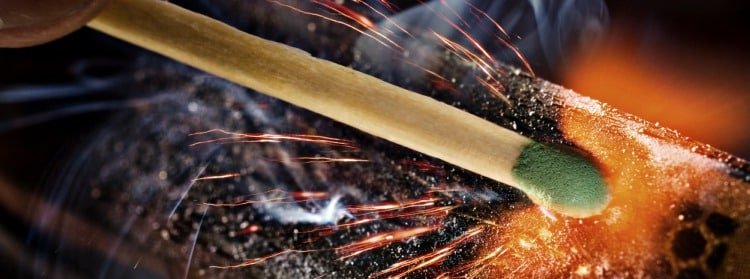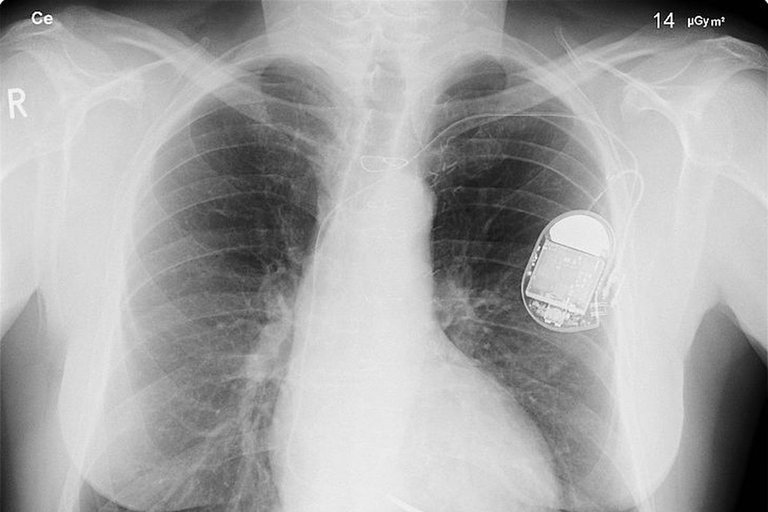- Self-Igniting Matches:

Humans have had fire for eons, and we’ve always looked for easy ways to start fires. The modern-day match transformed our world and enriched our way of life in ways their inventors could never have imagined, but early matches weren’t strikable or self-igniting and needed some other means to light. For example, early Chinese matches were coated with sulfur that burned very bright and were used to enlarge an existing fire quickly, but they never evolved beyond that ability.
First match was created in 1805 by Jean Chancel in Paris. This crude match looked nothing like the modern “striking” matches we use today. This crude match looked nothing like the modern “striking” matches we use today. Instead of using phosphorus, Chancel elected to coat wooden stick with potassium chlorate, sulfur, sugar, rubber, and then dip that stick into the small asbestos bottle filled with sulfuric acid. Connection between acid and the mixture on the stick would start the fire and release very nasty fumes into the face of the user.
The real breakthrough came in 1826, when an English chemist and druggist John Walker that truly managed to change the way we create fire.. While working in his lab, Walker noticed that a glob of chemicals he’d been working with earlier had dried and formed a lump on the end of his stir stick. Not wanting to mix the chemicals into his present experiment, he started scraping the stuff off the implement and was both startled and pleased when it burst into flame! Walker used a sulfur-based compound on the matches’ heads and rough paper coated with phosphorus to strike them with. The user would fold the paper over the match and pull it through while applying a bit of pressure to light it. He sold quite a few of these fire sticks, but they had a problem: The sulfur burned so violently that it would burn through the stick, and the flaming head would come off, many times with undesirable results.
After him, many other inventors added their contributions and advancements, eventually leading to the worldwide phenomenon of white phosphorus matches created by Frenchman Charles Sauria. Even though this type of matches was very popular, white phosphorus was eventually banned from public usage because of its toxic properties.
Matches these days are made from a red phosphorus concoction, first employed by Johan Edvard Lundstrom, which is completely nontoxic. Safety matches, which are familiar to most today, were first produced and sold in the United States by the Diamond Match Company, which gave up their rights to patent them so that any company could produce and market safety matches.
- Post-It Notes:

Post-It Notes were invented by accident. n 1968, a scientist working for the Minnesota Mining and Manufacturing Corporation (also known as 3M) named Spencer Silver was given the job of inventing a super adhesive designed exclusively to be used in the aerospace industry, a very tough industry to design for. Instead of a super strong adhesive, though, he accidentally managed to create an incredibly weak, pressure sensitive adhesive agent called Acrylate Copolymer Microspheres.
This adhesive did not interest 3M management as it was seen as too weak to be useful. It did have two interesting features, though. The first is that, when stuck to a surface, it can be peeled away without leaving any residue. Specifically, the acrylic spheres only stick well to surfaces where they are tangent to the surface, thus allowing weak enough adhesion to be able to be peeled easily. The second big feature is that the adhesive is re-usable, thanks to the fact that the spheres are incredibly strong and resist breaking, dissolving, or melting. Despite these two notable features, no one, not even Silver himself, could think up a good marketable use for it. Thus, even with Silver promoting it for five years straight to various 3M employees, the adhesive was more or less shelved.
Finally, in 1973, when Geoff Nicholson was made products laboratory manager at 3M, Silver approached him immediately with the adhesive and gave him samples to play with. Silver also suggested what he saw as his best idea for what to use the adhesive for, making a bulletin board with the adhesive sprayed on it. One could then stick pieces of paper to the bulletin board without tacks, tape, or the like. The paper could subsequently be easily removed without any residue being left on the sheets. While this was a decent idea, it wasn’t seen as potentially profitable enough as annual bulletin board sales are fairly low.
- Pacemakers:

A lot can happen in a minute. In the world of scientific invention, a minute can be pivotal. A spark can trigger a life-changing idea for an inventor in a minute, and 60 seconds is all it takes for an inventor to make a huge mistake. In some extraordinary cases, perhaps both phenomena can occur in that same moment in time. This was the case for Dr. Wilson Greatbatch
Wilson Greatbatch was an inveterate inventor, with more than 150 patents to his name. He will be best remembered for the invention and development of the first implantable pacemaker, a device which has improved, saved and extended countless lives since its first use in 1960. Worldwide, around three million people currently benefit from Greatbatch's discovery, with an additional 600,000 being implanted every year.
It was 1956. Wilson Greatbatch was working on a device to monitor and record the sounds of the human heart when he inserted a transistor into his device that was 100 times as powerful as he would normally use. His mistake caused the instrument to create electrical impulses that were perfectly emulating the beat of the heart. So, instead of ruining the thing, which could easily have happened, the device wasn’t monitoring the heartbeat; it was creating one! He was amazed when he quickly realized that his invention could be used as an internal pacemaker, an instrument which, at the time, had to be worn like a necklace, with the thing shocking the patient to keep their heart beating.
The very first pacemakers looked like a television that the patient was tethered to, and since battery power was insufficient at the time, they had to be plugged in as well. A patient who needed a pacemaker then was much like a person on dialysis; they couldn’t leave the machine, and they couldn’t carry it around. An internal pacemaker would allow millions of these people to live completely normal lives. So, a bit bigger than a hockey puck, Greatbatch’s first prototype was implanted into a dog in 1958 and controlled its heartbeat successfully and without difficulty. The first human patient to receive one was a 77-year-old man who lived 18 months, while a young recipient lived 30 years with his.
They did have their problems, though. Body fluids would permeate the device, ruining the circuitry, and batteries would last only about two years, so Greatbatch started looking for better ways to power them. In 1970, he started his own company, Greatbatch Inc., and developed lithium batteries that lasted ten years and would eventually be used in over 90 percent of pacemakers on the planet. Greatbatch patented more than 325 inventions in his lifetime. Beyond his pacemaker, he conducted important research in the areas of HIV treatments and renewable energy. Greatbatch boldly challenged modern scientists to end the world’s dependence on fossil fuels, working on a solution that would use helium-based fusion reaction for power generation.
Greatbatch received many awards throughout his lifetime. He was inducted into the National Inventors Hall of Fame and received the Lemelson-MIT Lifetime Achievement Award. He was also presented with the National Medal of Technology by President George H.W. Bush in 1990.
Greatbatch created one of the most significant inventions of the 20th century from a blatant miscalculation. What began as a failure became a groundbreaking idea that led to success. Greatbatch was a tenacious inventor who reminds us that failure itself is often the heartbeat of discovery – keeping invention alive by forcing us to continue searching for answers to the world’s most difficult questions.
- Microwave Ovens:

You push “2” on the keypad. A box lights up, and you see a plate rotating with a small, brown packet on it. Soon, a machine-gun rattle fills your kitchen air with the familiar, tantalizing odor of your favorite buttery snack. You have in front of you not only steaming hot and buttery popcorn but one of most prolific machines ever invented in history, and it was discovered by accident! It is the microwave.
There were theories that high-frequency electric fields could be used for heating as early as 1934 but this method used frequencies that are lower than those of microwaves. Between 1937 and 1940, British physicist Sir John Turton Randall, together with a team of British coworkers, developed multi-cavity magnetron which allowed for production of electromagnetic waves of a small enough wavelength (microwaves) and development of radar. Magnetron was given to the U.S. government in September 1940 in exchange for their financial and industrial help during the Second World War.
One of the companies that were given contract by U.S. government to build magnetrons was Raytheon an one of the engineers that worked for Raytheon was self-taught engineer from Howland, Maine - Percy Spencer. the main component of a radar system, when he found that a candy bar he was carrying in his shirt pocket had melted into a gooey mess while he was in close proximity to the device. His interest piqued, he placed an egg in the path of the magnetron’s rays and got a face full of egg for his trouble. He then got the idea to put some corn kernels on a plate, and he got them to pop all over the lab! The rest, as they say, was history. Percy Spencer is also credited with the invention of the proximity fuse, which allows bombs to explode above their targets for a much better effect.
- Fireworks:

The discovery of fireworks, or namely the formulation of gunpowder is believed to have occurred by chance approximately 2,000 years ago in China. In Chinese kitchen, a cook made one of the oldest accidental discoveries known to man when he mixed sulfur, saltpeter (potassium nitrile), and charcoal over a fire. Let’s just say combustion ensued. What the cook was thinking, or whether or not he made it to work the next day, is not known, but the he’d just made a discovery that would change the history of the world forever. The ancient Chinese called it “fire chemical” and quickly learned that when they compressed the concoction, such as inside a piece of bamboo, it exploded. Thus, the firecracker was born.
Thereafter, fire crackers played an essential part to Chinese festivities -weddings, religious rituals -nay cause for celebration heard their bang due to the belief that they were thought to be powerful enough to scare off evil spirits. They would eventually learn through experimentation that they could produce thrust that would propel the bamboo container through the air, instead of exploding instantly, and soon, the solid-fuel rocket was invented. They put the two together, firecrackers and rockets, and fireworks were born.
Before long, the knowledge of fireworks began to spread to the west. It is believed that Marco Polo on one of his many trips to China transported this invention to the Middle East where European Crusaders brought it to England. Although the English are credited for devising the standard recipe for black powder still in use today, it was the Italians who turned the making of fireworks into an art form, with the use of multiple colors and choreographed firework displays. Needless to say, the Italians’ celebrations got louder and more colorful as they experimented with different chemical combinations that would produce different colors when burned. However, none of it would have been possible if not for the accidental discovery of “fire chemical” by a 2,000-year-old Chinese cook.
good article
Thanks bro for your comment